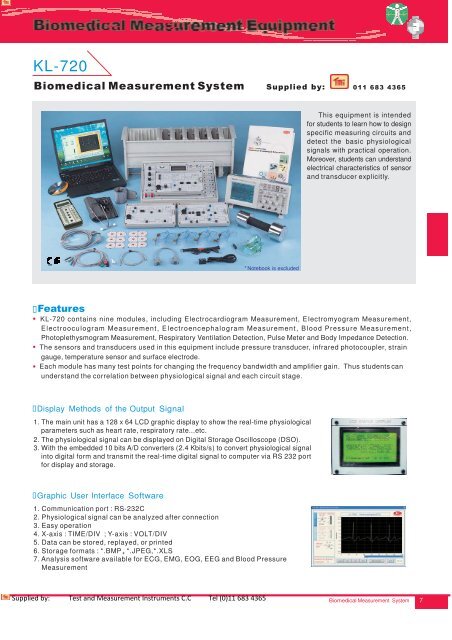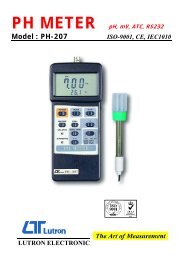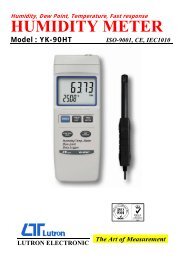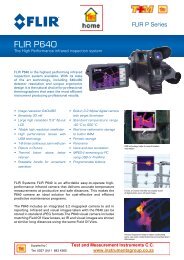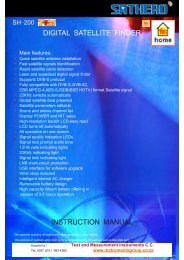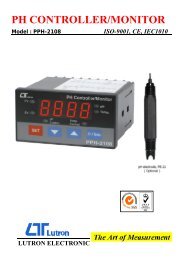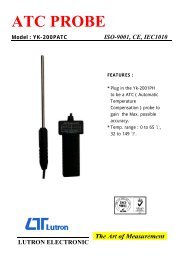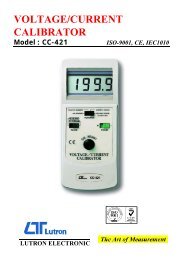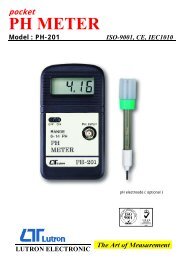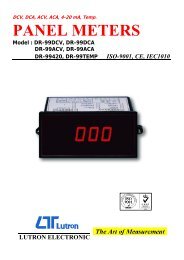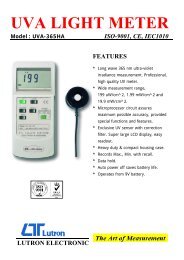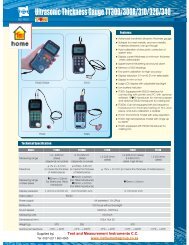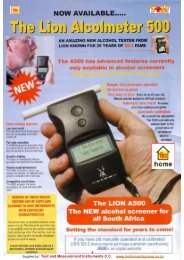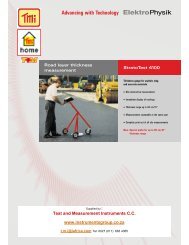KL-720 - Test and Measurement Instruments CC
KL-720 - Test and Measurement Instruments CC
KL-720 - Test and Measurement Instruments CC
Create successful ePaper yourself
Turn your PDF publications into a flip-book with our unique Google optimized e-Paper software.
<strong>KL</strong>-<strong>720</strong><br />
Biomedical <strong>Measurement</strong> System Supplied by: 011 683 4365<br />
This equipment is intended<br />
for students to learn how to design<br />
specific measuring circuits <strong>and</strong><br />
detect the basic physiological<br />
signals with practical operation.<br />
Moreover, students can underst<strong>and</strong><br />
electrical characteristics of sensor<br />
<strong>and</strong> transducer explicitly.<br />
* Notebook is excluded<br />
Features<br />
● <strong>KL</strong>-<strong>720</strong> contains nine modules, including Electrocardiogram <strong>Measurement</strong>, E lectromyogram <strong>Measurement</strong>,<br />
Electrooculogram <strong>Measurement</strong>, E lectroencephalogram <strong>Measurement</strong>, B lood Pressure <strong>Measurement</strong>,<br />
Photoplethysmogram <strong>Measurement</strong>, Respiratory Ventilation Detection, Pulse Meter <strong>and</strong> Body Impedance Detection.<br />
● The sensors <strong>and</strong> transducers used in this equipment include pressure transducer, infrared photocoupler, strain<br />
gauge, temperature sensor <strong>and</strong> surface electrode.<br />
● Each module has many test points for changing the frequency b<strong>and</strong>width <strong>and</strong> amplifier gain. Thus students can<br />
underst<strong>and</strong> the correlation between physiological signal <strong>and</strong> each circuit stage.<br />
Display Methods of the Output Signal<br />
1. The main unit has a 128 x 64 LCD graphic display to show the real-time physiological<br />
parameters such as heart rate, respiratory rate...etc.<br />
2. The physiological signal can be displayed on Digital Storage Oscilloscope (DSO).<br />
3. With the embedded 10 bits A/D converters (2.4 Kbits/s) to convert physiological signal<br />
into digital form <strong>and</strong> transmit the real-time digital signal to computer via RS 232 port<br />
for display <strong>and</strong> storage.<br />
Graphic User Interface Software<br />
1. Communication port : RS-232C<br />
2. Physiological signal can be analyzed after connection<br />
3. Easy operation<br />
4. X-axis : TIME/DIV ; Y-axis : VOLT/DIV<br />
5. Data can be stored, replayed, or printed<br />
6. Storage formats : *.BMP, *.JPEG,*.XLS<br />
7. Analysis software available for ECG, EMG, EOG, EEG <strong>and</strong> Blood Pressure<br />
<strong>Measurement</strong><br />
Supplied by: <strong>Test</strong> <strong>and</strong> <strong>Measurement</strong> <strong>Instruments</strong> C.C Tel (0)11 683 4365<br />
Biomedical <strong>Measurement</strong> System 7
Specifications<br />
Main Unit (<strong>KL</strong>-<strong>720</strong>01)<br />
2 3 6 7 8<br />
1<br />
4<br />
5<br />
<strong>KL</strong>-<strong>720</strong>01<br />
1. Function Generator<br />
a. Output waveform : Sine, square, triangle wave<br />
b. Frequency range : 0.1 Hz ~ 10KHz in 5 ranges,<br />
continuously adjustable<br />
c. Amplitude range : 30 mVpp ~ 18 Vpp (no load)<br />
2. RS-232 Port<br />
9600 bps baud rate, 2 start bits, 8 data bits, 1 stop bit<br />
3. Input Indicators<br />
IN1、IN2、IN3、IN4、IN5 LED to lead the student<br />
connecting the sensor used for ECG, EMG, EOG,<br />
EEG <strong>and</strong> body impedance.<br />
4. Reset Switch<br />
For MCU reset<br />
5. Select Switch<br />
Select the module<br />
9<br />
6. LCD Status Display<br />
a. Display the frequency of function generator<br />
b. Display the measurement modules:<br />
Electrocardiogram measurement, Electromyogram<br />
measurement, Electrooculogram measurement,<br />
Electroencephalogram measurement, B lood<br />
pressure measurement, Photoplethysmogram<br />
measurement, Respiratory ventilation detection,<br />
Pulse meter, Body impedance detection<br />
c. Heart Rate (<strong>KL</strong>-75006), Respiration (<strong>KL</strong>-75007)<br />
<strong>and</strong> Pulse Rate (<strong>KL</strong>-75008).<br />
7. BNC Adaptor Connector<br />
For 2mm socket / BNC socket<br />
8. Module Output<br />
DB9 connector<br />
9. Output<br />
a. Electrocardiogram (ECG) : One output<br />
b. Electromyogram (EMG) : Two outputs<br />
c. Electrooculogram (EOG) : Two outputs<br />
d. Electroencephalogram (EEG) : One output<br />
e. Blood pressure measurement : Two outputs<br />
f . Photoplethysmogram : Two outputs<br />
g. Respiratory ventilation : Two outputs<br />
h. Pulse meter : Two outputs<br />
i . Impedance<br />
: One output<br />
Module Units (<strong>KL</strong>-75001~75009)<br />
<strong>KL</strong>-75001 Electrocardiogram(ECG) <strong>Measurement</strong><br />
Feature:<br />
Underst<strong>and</strong> the phenomenon of the action potential when heart beats. This<br />
measurement module uses six limb leads to detect the electrocardiogram. With<br />
the explicit experimental procedure, students learn how to design the Wilson<br />
network <strong>and</strong> the isolated circuits easily.<br />
Specifications List of Experiments Equipment Required<br />
1. Limb lead inputs<br />
2. Limb electrode<br />
3. Six limb leads : Lead I, Lead II, Lead III,<br />
aV R , aV L , aV F<br />
4. Isolation circuit<br />
5. Gain : 100~5000<br />
6. B<strong>and</strong>-pass filter : 0.1~100 Hz<br />
7. One output<br />
ECG signal<br />
1. HPF Characteristic Experiment<br />
2. Amplifier Experiment<br />
3. LPF Characteristic Experiment<br />
4. BRF Characteristic Experiment<br />
5. ECG Simulator Experiment (Optional)<br />
6. ECG Experiment<br />
1. <strong>KL</strong>-<strong>720</strong>01 Main Unit<br />
2. <strong>KL</strong>-75001 Electrocardiogram Module<br />
3. Digital Storage Oscilloscope<br />
4. Lead Clamp -<br />
5. Electrode Lead - 15<br />
6. 5-Conductor Electrode Cable - 16<br />
7. Alcohol Prep. Pad -<br />
8. Trimmer<br />
9. Connection Leads - 17<br />
10. 2mm Bridging Plug - 18<br />
11. 2mm Terminal - 19<br />
● Optional : ECG Simulator, DSO<br />
11 7<br />
8 Biomedical <strong>Measurement</strong> System Supplied by <strong>Test</strong> <strong>and</strong> <strong>Measurement</strong> <strong>Instruments</strong> C.C. Tel (011) 683 4365 www.instrumentsgroup.co.za
<strong>KL</strong>-75002 Electromyogram (EMG) <strong>Measurement</strong><br />
Feature:<br />
Comprehend the electrical activity of muscle under the isotonic <strong>and</strong> isometric<br />
conditions <strong>and</strong> simultaneously detect the amount of muscle force. From the measured<br />
waveform, students can realize the motion function made by the skeletal muscle specific.<br />
Specifications List of Experiments Equipment Required<br />
1. Surface electrode<br />
2. Gain : x 1000, x 2000<br />
3. Isolation circuit<br />
4. B<strong>and</strong>-pass filter : 100 ~1000 Hz<br />
5. Two outputs<br />
a. Electromyogram signal<br />
b. Muscle force signal<br />
1. BRF Characteristic Experiment<br />
2. LPF Characteristic Experiment<br />
3. Gain Amplifier Experiment<br />
4. HPF Characteristic Experiment<br />
5. Half-Wave Rectifier Characteristic<br />
Experiment<br />
6. Integrator Characteristic Experiment<br />
7. EMG Experiment<br />
1. <strong>KL</strong>-<strong>720</strong>01 Main Unit<br />
2. <strong>KL</strong>-75002 Electromyogram Module<br />
3. Digital Storage Oscilloscope<br />
4. Body Surface Electrodes -<br />
5. Electrode Lead - 15<br />
6. 5-Conductor Electrode Cable - 16<br />
7. Alcohol Prep. Pad -<br />
8. Dumbbell (5kg) -<br />
9. Trimmer<br />
10. Connection Leads - 17<br />
11. 2mm Bridging Plug - 18<br />
12. 2mm Terminal -<br />
8<br />
● Optional : DSO<br />
1 11 19<br />
<strong>KL</strong>-75003 Electrooculogram (EOG) <strong>Measurement</strong><br />
Feature:<br />
Have a through grasp of the electrical activity of the eye muscle under eye movements.<br />
Two kinds of electrical signal from horizontal <strong>and</strong> vertical movements of the eye ball are<br />
detected <strong>and</strong> processed in the module.<br />
Specifications List of Experiments Equipment Required<br />
1. Surface electrode<br />
2. Gain : 5~3000<br />
3. Isolation circuit<br />
4. B<strong>and</strong>-pass filter : 0.05~30 Hz<br />
5. Two outputs<br />
a. Horizontal signal<br />
b. Vertical signal<br />
1. Horizontal & Vertical Electro Circuit<br />
Calibration Experiment<br />
2. BRF Characteristic Experiment<br />
3. HPF Characteristic Experiment<br />
4. Amplifier Experiment<br />
5. LPF Characteristic Experiment<br />
6. EOG Experiment<br />
1. <strong>KL</strong>-<strong>720</strong>01 Main Unit<br />
2. <strong>KL</strong>-75003 Electrooculogram Module<br />
3. Digital Storage Oscilloscope<br />
4. Body Surface Electrodes -<br />
5. Electrode Lead - 15<br />
6. 5-Conductor Electrode Cable - 16<br />
7. Alcohol Prep. Pad -<br />
8. Trimmer<br />
9. Connection Leads - 17<br />
10. 2mm Bridging Plug - 18<br />
11. 2mm Terminal -<br />
8<br />
● Optional : DSO<br />
11 19<br />
<strong>KL</strong>-75004 Electroencephalogram (EEG) <strong>Measurement</strong><br />
Feature:<br />
Underst<strong>and</strong> the electrical activity of the brain. In the experimental procedure,<br />
theα-wave will be evoked when the eyes open <strong>and</strong> close. Because the EEG signal<br />
is very weak, this module implements a high gain amplifier <strong>and</strong> filters to avoid the noise.<br />
Specifications List of Experiments Equipment Required<br />
1. EEG electrode<br />
2. Gain : 50~5000<br />
3. Isolation circuit<br />
4. B<strong>and</strong>-pass filter : 1~20 Hz<br />
5. One output<br />
EEG signal<br />
1. Pre-Amplifier Calibration Experiment<br />
2. BRF Characteristic Experiment<br />
3. HPF Characteristic Experiment<br />
4. Amplifier Experiment<br />
5. LPF Characteristic Experiment<br />
6. EEG Experiment<br />
1. <strong>KL</strong>-<strong>720</strong>01 Main Unit<br />
2. <strong>KL</strong>-75004 Electroencephalogram Module<br />
3. Digital Storage Oscilloscope<br />
4. EEG Electrode - 13<br />
5. 5-Conductor Electrode Cable - 16<br />
6. Alcohol Prep. Pad<br />
7. Electrical Conductivity Jelly -<br />
8. Medical Tape -<br />
9. Elastic Head B<strong>and</strong>age -<br />
10. Trimmer<br />
11. Connection Leads - 17<br />
12. 2mm Bridging Plug - 18<br />
13. 2mm Terminal -<br />
-11<br />
● Optional : DSO, EEG Simulator<br />
9 10 2<br />
19<br />
Supplied by: <strong>Test</strong> <strong>and</strong> <strong>Measurement</strong> <strong>Instruments</strong> C.C Tel (0)11 683 4365<br />
Biomedical <strong>Measurement</strong> System 9
<strong>KL</strong>-75005 Blood Pressure <strong>Measurement</strong><br />
Feature:<br />
Realize how to measure the blood pressure noninvasively <strong>and</strong> compare its accuracy<br />
with the auscultator <strong>and</strong> oscillometric method. In this experiment, students know the<br />
way to calibrate the pressure transducer directly <strong>and</strong> indirectly.<br />
Specifications List of Experiments Equipment Required<br />
1. Pressure transducer:<br />
a. Differential pressure model<br />
b. Pressure range : 0~5 psid<br />
c. Accuracy : 0.5 %<br />
d. Input impedance : 5KΩ<br />
2. Pressure calibration circuit<br />
3. Gain amplifier:20~800<br />
4. B<strong>and</strong>-pass filter : 0.3~3 Hz<br />
5. Two outputs<br />
a. Cuff pressure signal<br />
b. Oscillometric pulse signal<br />
1. Pressure Sensor Calibration Experiment<br />
2. HPF1 Characteristic Experiment<br />
3. LPF Characteristic Experiment<br />
4. HPF2 & Amplifier Characteristic<br />
Experiment<br />
5. Rectifier Characteristic Experiment<br />
6. Auscultatory Blood Pressure<br />
measurement Experiment<br />
7. Oscillometric Blood Pressure<br />
<strong>Measurement</strong> Experiment<br />
1. <strong>KL</strong>-<strong>720</strong>01 Main Unit<br />
2. <strong>KL</strong>-75005 Blood Pressure<br />
<strong>Measurement</strong> Module<br />
3. Digital Storage Oscilloscope<br />
4. Mechanical Sphygmomanometer -<br />
5. Trimmer<br />
6. Connection Leads - 17<br />
7. 2mm Bridging Plug - 18<br />
8. 2mm Terminal<br />
● Optional : DSO<br />
-19 3<br />
<strong>KL</strong>-75006 Photoplethysmogram <strong>Measurement</strong><br />
Feature:<br />
See how to use the noninvasive method <strong>and</strong> configure the circuit to detect <strong>and</strong><br />
process the Plethysmogram. The volume change of blood capillary is detectable by<br />
an infrared photocoupler.<br />
Specifications List of Experiments Equipment Required<br />
1. Infrared light-emitting diode<br />
a. Rated forward current<br />
IF = 60 mA<br />
b. Rated reverse voltage<br />
VR = 4 V<br />
c. Peak wavelength<br />
λp = 880 nm<br />
d. ∆θ = ± 53 deg<br />
2. Phototransistor<br />
a. Rated C-E voltage<br />
VCEO = 20 V<br />
b. Rated collector power<br />
Pc = 75 mW<br />
c. Peak wavelength<br />
λp = 800 nm<br />
d. ∆θ = ± 50 deg.<br />
3. Gain : x 50~500, x 100~1000<br />
4. B<strong>and</strong>-pass filter : 0.3~40 Hz<br />
5. Two outputs<br />
a. Plethysmogram signal<br />
b. Heart rate pulse<br />
1. Infrared Photocoupler Calibration<br />
Experiment<br />
2. HPF Characteristic Experiment<br />
3. Gain Amplifier Experiment<br />
4. 4th-order LPF Characteristic<br />
Experiment<br />
5. Differentiator Experiment<br />
6. Amplifier Experiment<br />
7. Comparator Experiment<br />
8. Monostable Multivibrator Experiment<br />
9. Photoplethysmogram<br />
<strong>Measurement</strong> Experiment<br />
1. <strong>KL</strong>-<strong>720</strong>01 Main Unit<br />
2. <strong>KL</strong>-75006 Photoplethysmogram Module<br />
3. Digital Storage Oscilloscope<br />
4. Infrared Photocoupler Sensor - 14<br />
5. Trimmer<br />
6. Connection Leads - 17<br />
7. 2mm Bridging Plug - 18<br />
8. 2mm Terminal -<br />
● Optional : DSO<br />
19<br />
10 Biomedical <strong>Measurement</strong> System Supplied by <strong>Test</strong> <strong>and</strong> <strong>Measurement</strong> <strong>Instruments</strong> C.C. Tel (011) 683 4365 www.instrumentsgroup.co.za
<strong>KL</strong>-75007 Respiratory Ventilation Detection<br />
Feature:<br />
To learn the usage of temperature sensor <strong>and</strong> circuit configuration, users can comprehend<br />
how to detect <strong>and</strong> process the respiratory signal including stop breathing capacity,<br />
over-respiration <strong>and</strong> respiratory rate.<br />
Specifications List of Experiments Equipment Required<br />
1. Temperature sensor<br />
a. Thermister : 5KΩ (at 25°C)<br />
b. Tolerance : ± 5%<br />
2. With temperature compensation circuit<br />
3. Gain : 20<br />
4. Two outputs<br />
a. Pneumograph signal<br />
b. Respiratory rate pulse<br />
1. Differential Amplifier Calibration<br />
Experiment<br />
2. BRF Characteristic Experiment<br />
3. Amplifier Experiment<br />
4. Differentiator Experiment<br />
5. Hysteresis Comparator Experiment<br />
6. Monostable Multivibrator Experiment<br />
7. Respiratory Ventilation Detection<br />
Experiment<br />
1. <strong>KL</strong>-<strong>720</strong>01 Main Unit<br />
2. <strong>KL</strong>-75007 Respiratory Ventilation Module<br />
3. Digital Storage Oscilloscope<br />
4. Temperature Sensor Mask -<br />
5. Trimmer<br />
6. Alcohol Prep. Pad -<br />
7. Connection Leads - 17<br />
8. 2mm Bridging Plug - 18<br />
9. 2mm Terminal - 19<br />
● Optional : DSO<br />
11 6<br />
<strong>KL</strong>-75008 Pulse Meter<br />
Feature:<br />
Underst<strong>and</strong> how to use the strain gauge <strong>and</strong> configure the circuit for detecting <strong>and</strong><br />
processing the radial pulse waveform <strong>and</strong> learn vascular characteristics under different<br />
Transmural pressure conditions.<br />
Specifications List of Experiments Equipment Required<br />
1. Strain gauge<br />
5 mm grid, 120Ω<br />
2. Gain : x 2500, x 5000<br />
3. B<strong>and</strong>-pass filter : 0.05 ~ 40 Hz<br />
4. Two outputs<br />
a. Pulse wave<br />
b. Heart rate pulse<br />
1. Strain Gauge Amplifier Calibration<br />
Experiment<br />
2. HPF Characteristic Experiment<br />
3. BRF Characteristic Experiment<br />
4. Gain Amplifier Experiment<br />
5. LPF Characteristic Experiment<br />
6. Hysteresis Comparator Experiment<br />
7. Monostable Multivibrator Experiment<br />
8. Pulse Meter Experiment<br />
9. Arterial Vessel Experiment<br />
1. <strong>KL</strong>-<strong>720</strong>01 Main Unit<br />
2. <strong>KL</strong>-75008 Pulse Meter Module<br />
3. Digital Storage Oscilloscope<br />
4. Strain Gauge Tie - 12<br />
5. Wrist-type Cuff -<br />
6. Mechanical Sphygmomanometer -<br />
7. Trimmer<br />
8. Connection Leads - 17<br />
9. 2mm Bridging Plug - 18<br />
10. 2mm Terminal - 19<br />
● Optional : DSO<br />
3 4<br />
<strong>KL</strong>-75009 Body Impedance Detection (People with cardiac pacemaker must avoid using this)<br />
Feature:<br />
Realize how to detect the body impedance. Injecting a constant alternating current to<br />
the body <strong>and</strong> passing through the chest, a change of body impedance will be detected<br />
when chamber volume of the ventricle <strong>and</strong> atrium is changed.<br />
Specifications List of Experiments Equipment Required<br />
1. B<strong>and</strong>-pass filter : 0.1~10Hz<br />
2. Sine wave generator circuit : 50 KHz<br />
3. Surface electrode<br />
4. Isolation circuit<br />
5. Gain : x 1250, x 2500<br />
6. With overcurrent protection <strong>and</strong> reset<br />
circuits<br />
7. One output<br />
Body impedance signal<br />
1. Pre-Amplifier Calibration Experiment<br />
2. BRF Characteristic Experiment<br />
3. Wien-Bridge Oscillator Experiment<br />
4. HPF Characteristic Experiment<br />
5. Demodulator Experiment<br />
6. Gain Amplifier Experiment<br />
7. LPF Characteristic Experiment<br />
8. Impedance Detection Experiment<br />
1. <strong>KL</strong>-<strong>720</strong>01 Main Unit<br />
2. <strong>KL</strong>-75009 Impedance Module<br />
3. Digital Storage Oscilloscope<br />
4. Body Surface Electrodes -<br />
5. Electrode Lead - 15<br />
6. 5-Conductor Electrode Cable - 16<br />
7. Alcohol Prep. Pad -<br />
8. Trimmer<br />
9. Connection Leads - 17<br />
10. 2mm Bridging Plug - 18<br />
11. 2mm Terminal -<br />
8<br />
● Optional : DSO<br />
11 19<br />
Supplied by: <strong>Test</strong> <strong>and</strong> <strong>Measurement</strong> <strong>Instruments</strong> C.C Tel (0)11 683 4365<br />
Biomedical <strong>Measurement</strong> System 11
3 4 1<br />
2<br />
7 9<br />
Dumbbell<br />
5<br />
Body<br />
1<br />
8 11<br />
13<br />
15 16 14<br />
Experiment Module Features<br />
1. All terminals on the module accepts 2mm plugs.<br />
2. Circuit symbols, blocks <strong>and</strong> components are printed on the surface of each module.<br />
3. Modules are secured in plastic housings.<br />
4. Dimension : 255x165x30mm 10%<br />
5. With storage cabinet for easy storing<br />
6. Comprehensive experiment <strong>and</strong> instructor's manuals are provided.<br />
Accessories<br />
Optional Accessories<br />
1. Digital Storage Oscilloscope (DSO)<br />
2. <strong>KL</strong>-79106 ECG simulator<br />
3. EEG simulator<br />
4. Electrical conductivity jelly<br />
5. Body surface electrode<br />
6. Alcohol prep pad<br />
7. Elastic head b<strong>and</strong>age<br />
8. Temperature sensor mask<br />
9. Medical tape<br />
NOTE : Since item No. 5 to 9 are consumer goods, the order quantity depends on user’s choice.<br />
Digital Storage Oscilloscope<br />
<strong>KL</strong>-79106 ECG simulator EEG simulator<br />
(Pathological Signals)<br />
St<strong>and</strong>ard Accessories (<strong>KL</strong>-79002)<br />
conductivity jelly<br />
sphygmomanometer<br />
cuff<br />
box<br />
sensor mask<br />
clamp<br />
surface electrodes<br />
head b<strong>and</strong>age<br />
tape<br />
prep pad<br />
2 Electrical<br />
3 Mechanical<br />
4 Wrist-type<br />
5 Accessory<br />
gauge tie<br />
6<br />
6 Temperature<br />
7 Lead<br />
10<br />
electrode<br />
8<br />
12<br />
photocoupler sensor<br />
lead<br />
electrode cable<br />
leads<br />
bridging plug<br />
terminal<br />
to USB adaptor<br />
9 Elastic<br />
10 Medical<br />
11 Alcohol<br />
12 Strain<br />
13 EEG<br />
17 18 19 20<br />
12 Biomedical <strong>Measurement</strong> System Supplied by <strong>Test</strong> <strong>and</strong> <strong>Measurement</strong> <strong>Instruments</strong> C.C. Tel: (011) 683 4365 www.instrumentsgroup.co.za 10101<br />
14 Infrared<br />
15 Electrode<br />
20 RS-232C<br />
16 5-conductor<br />
19 2mm<br />
17 Connection<br />
18 2mm


